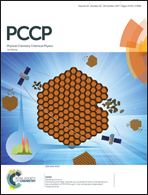Dynamics of the crystal structure of tin-based type-I clathrates with different degrees of disorder in their cationic frameworks
Abstract
The temperature dependencies of heat capacity, CP(T), and cubic unit cell parameter, a(T), were experimentally obtained in the range of 2–300 K for the compounds Sn24P19.2I8, Sn20Zn4P20.8I8, and Sn17Zn7P22I8, which belong to a family of type-I clathrates. The experimental data were analyzed in the frames of the Debye–Einstein approximation, further accounting for the contributions of positional disorder in the clathrate frameworks as well as those of defect modes arising from the distribution of guest atoms over unequal in energy but close in space positions inside the framework cages. By fitting the experimental data, the Debye and Einstein characteristic temperatures describing the dynamics of the framework and guest atoms, respectively, were obtained. Their analysis revealed peculiar dependencies of the characteristic temperatures upon the number of substituted zinc atoms and the concentration of vacancies in the framework, which are discussed in this paper.



 Please wait while we load your content...
Please wait while we load your content...